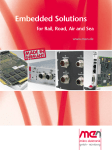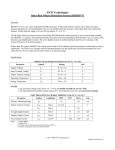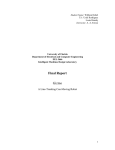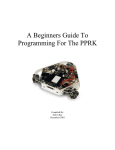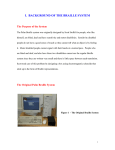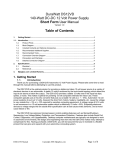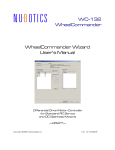Download Autonomous GPS Controlled Car ECE 3992 Senior Design Project
Transcript
Autonomous GPS Controlled Car ECE 3992 Senior Design Project Proposal Huy Vo Seth Thorup Brian Bradford Bryce McAllister I. Autonomous GPS -Controlled Car The autonomous GPS-controlled car will navigate itself using GPS-defined way points. It will be able to avoid large obstacles that might lay in its path by using a collisiondetection and avoidance system embedded in the car. A few examples of the operation of the car are listed here: a) The operator will give the car one specific way point to drive to. The car will drive to that point, avoiding obstacles along the way, and stop there to await further instructions. b) The operator will give the car a course to travel defined by many way points. The car will follow that course by visiting each way point in turn until it has finished the course where it will stop to await further instruction. c) The operator will give the car a path to travel as in the example above, but will tell the car to continue following the path back and forth until it is told to stop. In other words, the car will visit each way point in turn until it gets to the last one where it will turn around and visit the points again in reverse order, repeating this until told by the operator to stop. Many other interesting functions might be possible as explained in the “Possible Extensions and Add-ons” sections of this paper. This paper describes the proposed project in more detail along with potential risks and proposed scheduling. It contains the following sections. II. III. IV. V. VI. VII. VIII. IX. X. Technical Overview Hardware of the Autonomous Car Software of the Autonomous Car Interfaces Risk Assessment Proposed Individual Tasking Tentative Project Schedule Bill of Materials Possible Extensions and Add-Ons II. Technical Overview The GPS-controlled car will consist of these 5 major components. 1) 2) 3) 4) 5) The motor system The GPS system The collision avoidance system User input Software 1) The motor system will be composed of the dc servo motors that run the car as well as the wheels and body of the car, the processor, the motor control circuit, and a software driver. The processor will drive the car using four outputs to the motor control circuit: forward, reverse, left, and right (stopping will be the absence of a forward or backward command). It will do this by means of the software driver. The motor control circuit will consist of an H-bridge that executes the forward and reverse commands, as well as a circuit that will execute the turn left and turn right commands. 2) The GPS system will include a GPS chip, GPS antenna, the processor and a GPS software driver. The driver will allow the processor to communicate with the GPS chip via serial communication to receive environment data such as latitude, longitude, altitude, velocity, and heading. The antenna connects directly to the chip. 3) The collision avoidance system consists of infrared sensors that detect objects within a specified range, the processor, and a somewhat complex software routine. The processor will gather data from the sensors and use the data as input to the software that will decide the best course of action to take to avoid hitting the obstacle. 4) The User input system involves detecting when user input has been entered and jumping to a handler to accept the input. Possible types of input will be defining way points or a course, setting a speed, starting and stopping. 5) The software will consist of all of the above mentioned drivers and routines plus the main program that unites all the different components into the functioning GPScontrolled car. This will involve continually collecting data from the different components and deciding the plan of action to take based on that data. III. Hardware of the Autonomous Car Car – The basic car unit (body, wheels, motors, power supply) will come from a commercially available radio controlled car. We will use the above mentioned parts but we will redesign and implement all of the internal circuitry. The initial car will be a Tyco Grave Digger RC truck as shown below. After the GPS Car is functional, if we decide we want a more powerful model we will use a different car. Grave Digger Motors – The DC servo motors that we will use come with the above mentioned truck. Motor Power Supply – The Grave Digger uses a 6.0V battery pack. This power will not be used for the internal circuitry. It will only be used to power these motors. H-Bridge – An H-bridge circuit will be used to control the forward/reverse motor. We will implement the bridge shown on page 474 of Embedded Microcomputer Systems. We will use the Grave Digger’s own motor control circuit for left/right control. GPS Receiver Chip – This will be the center of the on-board navigation system. The GPS chip will receive signals from the GPS satellites and will communicate the necessary information to the processor. The information that can be sent to the processor includes the car’s latitude, longitude, height, velocity, heading, and time. All of this information might not be needed for the basic operation of the car, but it will be useful when we begin to add additional capabilities. We will be using Motorola’s FS Oncore GPS chip (below) which we can get at a discount through Synergy Systems’s GPS for Scholars program. FS Oncore GPS Antenna – The GPS receiver will need an antenna to accurately receive the signals from the GPS satellites. Motorola’s Hawk GPS antenna is included in the starter kit that we will purchase from Synergy Systems. Microcontroller – The brains of the autonomous car will be an 8-bit RISC-architecture processor. This will need to communicate with the GPS chip to find out the position, heading, and speed of the car. The processor will use this information to determine the best way to get to the desired way point. It will control the motor driver circuit to adjust the car’s position and speed as needed. The processor will also receive information from the infrared sensors. It will use this information to detect if an obstacle is in the current path. If it encounters an obstacle it will avoid it by driving the car around it, or backing up and trying an alternate path. We will be using an Atmel 8 bit AVR microcontroller, specifically the AT90S8535. IR Sensors – The eyes of the collision detection and avoidance system will be 3 infrared sensors mounted on the front of the car. There will be one in the center to detect head-on collisions and one on either side at an angle to detect obstacles, such as walls, on the sides. We will use Sharp’s GP2D05 IR Ranger Sensors. Input Switches and Buttons – We will need a few buttons and switches on the car to control functionality. We will need a switch for the digital power supply, a button to manually input GPS way points, and another button to select the operating mode of the vehicle. Other buttons may be necessary as we add to the functionality of the car. Digital Power Supply – The power used for the digital components of the car will be different from the motor’s power supply. We will most likely use batteries to get the required voltages. Both the processor and the sensors will require a voltage between 4 and 7 volts depending on the processor we use. We can use a simple voltage divider to get the 3V source needed by the GPS chip. Breadboard – The initial prototype of the GPS car will use a breadboard for the internal circuitry. Once it is functioning, we might opt to use wire-wrapping or a PCB. IV. Software of the Autonomous Car All of the software used by the car will be embedded in the processor’s EEPROM. The software will include drivers to communicate with the different components, and a main part that takes control of the car. A driver will be needed to control the GPS chip and allow communication to take place between the GPS chip and the processor. Another driver will control and communicate with the infrared sensors. The third driver will be used to communicate with the motor control circuit. There will need to be collision detection and avoidance software that checks for obstacles and reacts to them. This could involve navigating around the object; stopping, backing up, and finding a different path; navigating alongside a wall or building, etc. Another part of the software will communicate with the GPS to find the current location and use that to calculate a route that will lead to the desired location. There will also be interrupt handlers to handle input. The main program will use all of these software components to gather the necessary data to control the car. V. Interfaces Processor to GPS – Motorola’s Oncore GPS chip uses a TTL serial communication interface at a 9600 baud rate to send data to the processor. It can operate in either continuous mode or polled mode. Both modes will be useful for our project. If the car is far away from the way point it can operate in polled mode, updating it’s position every few seconds. This would save power since the GPS and processor wouldn’t be sending data back and forth continuously. As the car gets closer to its destination it could switch to continuous mode in order to get more accurate positioning. Commands are sent from the processor to request the desired information from the GPS chip. Processor to IR Sensors – The Sharp IR Ranger Sensors use a 2-wire serial interface to detect the presence of objects in a 10-80 cm range. The range can be set by a dial on the back of the sensors. We will have to test different ranges on the three sensors to get optimal performance. The sensors only take readings when requested. The protocol for detecting an object is extremely simple. To request a reading the processor will lower the input line, wait between 28 and 56 ms and then read the output line. A one on the output line means there is no object within the specified range. A zero on the output line means an object has been detected. Because the sensors use a lower voltage than the processor we will need to use a diode to drop the voltage on the input to the sensor. The output voltage from the sensor should be high enough for the processor to detect without amplifying it. Processor to Motor Control – The processor will control the car’s motors by means of a motor control circuit. This will most likely be a combination of the circuitry that came with the Grave Digger and our own H-bridge circuit. The processor will have four control lines sinking current to the motor control circuit: forward, reverse, left, and right. Input to Processor – The processor will use interrupt driven inputs to accept commands from the operator. The operator will be able to select different modes of operation such as fast or slow, more accurate positioning, and course-repeat mode. The operator will also be able to manually enter way points. The input will be done by means of simple push-buttons. VI. Risk Assessment The following table summarizes the foreseeable risks of building the Autonomous GPScontrolled car. Task MotorControl Circuit. Interfacing the GPS chip to the processor Collision Detection and Avoidance Risk Level Nature Back-up Plan Medium Because we are using a preassembled RC car, we will need to experiment with the motors to find out exactly how they are controlled. Once we can control them we will be able to build an h-bridge circuit compatible with the processor. We can use the motor control circuitry that came with the car. If we cannot get that to function properly, we can search for a different RC car that we know we can get the motor information for. Failing this we could build our own car using dc servo motors. We want to avoid this at all costs however, as we would rather spend the time giving the car more functionality. Low to None No one in our group has experience working with a GPS chip. This risk is not very high however, because the chip comes with sufficient documentation, and we all have experience working with the standard TTL serial interface. There is no back up plan if we fail here. The whole project is based upon the car navigating itself using GPS. If we cannot get this working, our project will not work. This does not worry us very much however because the level of this risk is very low. Low to None Again, no one in our group has a lot of experience working with infrared sensors, but the protocol used here is extremely simple and the sensors will have more than enough documentation to go along with them. Also, we all have experience writing input-driven programs. If we cannot get this system to function properly, the car will still operate but it will have to operate in an obstacle- free environment. However, we are confident that we can implement at least a very basic collision avoidance system. Digital Power Supply Software Low This is a risk because there are three different components that all require a slightly different voltage level: the microcontroller, the GPS chip, and the IR sensors. This risk is low because all of the voltage levels are low and close to each other. We can use a separate power supply for each component. This will most likely not be necessary, but if so the car will still run. It will just be a little heavier and slower, and will consume more power. Medium Although the software needed to operate each component of the car will not be overly complicated, each piece will require precise detail. Integrating all of the software into one operational module will be a little more complicated and will potentially require a lot of debugging, testing, and redesigning. We have a lot of programming experience, so given enough time, we will make it work. We can make the operation of the car more basic. This will decrease the difficulty of the software. XII. Proposed Individual Tasking To create all of the different systems of the car we will mostly work in teams of two. Integrating the systems into the final project will require the four of us working together. The different systems of the car will be divided up based on individual skill and interest. Here is a chart containing proposed tasking assignments. Task Motor control system Huy GPS system ? Seth ? User input Brian Bryce ? ? ? ? Collision avoidance ? Software ? ? ? ? Documentation ? ? ? ? ? VIII. Proposed Schedule IX. Bill of Materials Part Primary Supplier Secondary Supplier Cost Estimate RC Car Walmart (already purchased) $30 GPS Development Board Synergy Systems Acroname $150 FS Oncore User’s Manual Synergy Systems Motorola $50 Microcontroller All American Semiconductor Arrow Electronics $10 IR Sensors (3) Acroname Sharp $19 x 3 = $57 Miscellaneous Parts (batteries, resistors, capacitors, buttons, etc.) U of U Radio Shack $30 Total X. $320 Possible Extensions and Add-Ons Once we have completed the basic operation of the car as described above, we would like to try and add more functionality. Here are a few ideas we have thought about implementing. 1) On-the- fly waypoint updating: We would like to transmit new instructions and waypoints to the car remotely. This would allow us to stop the car in the middle of its current route and send it to a different location. This would also give us the freedom to define an initial course for the car remotely other than manually entering each waypoint. We could use regular radio transmission used in RC cars to transmit the data. 2) Visual acquisition: This would involve installing a simple digital camera on the car. We would be able to give the car a waypoint and a heading, then have it drive there, snap a picture, and return. If possible, we would also like the car to transmit the photo to us wirelessly. 3) Data acquisition: The car would be able to communicate wirelessly with a control center. It could then transmit data such as current position, speed, heading, obstacles, mechanical problems, estimated time of arrival, waypoint achieved, etc.














